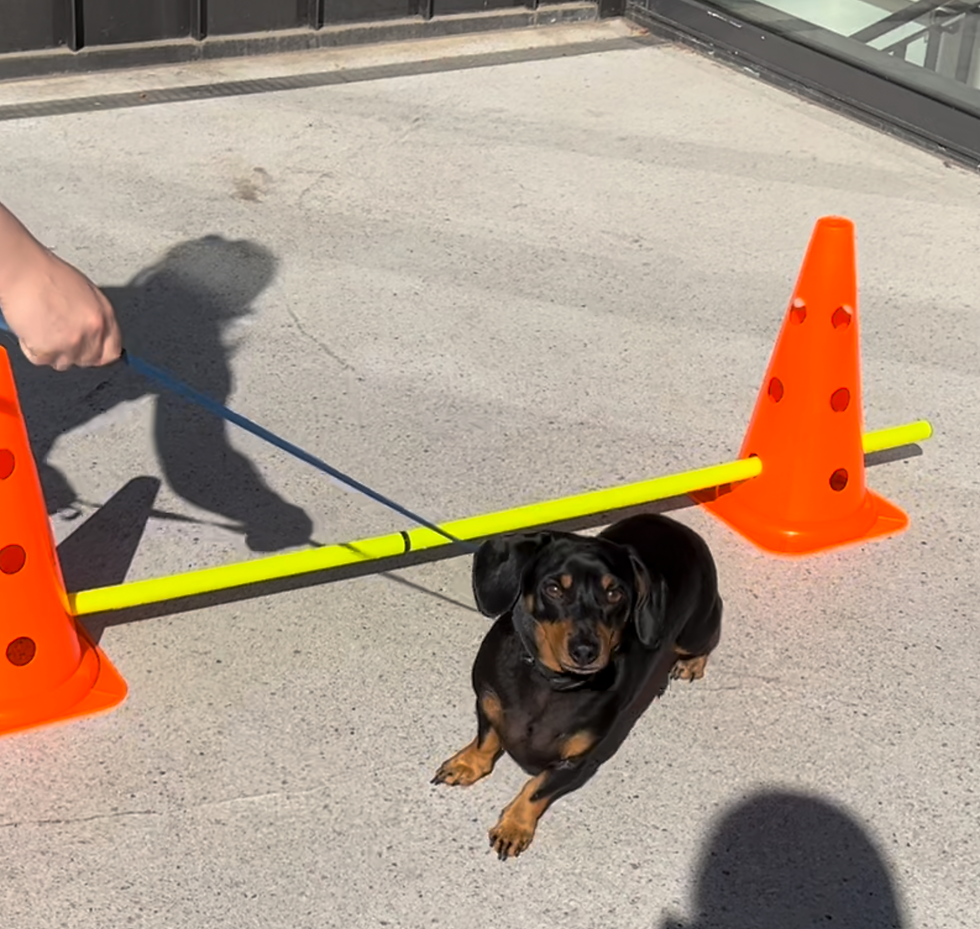What do we know about Cavaletti?
- Ah Young Kim
- Jun 28
- 4 min read

We use it all the time — but do we really understand it?
Well well well. Cavaletti.
We see it, we use it, we prescribe it.
But how much do we actually know about it?
✨ My next deep dive (following the previous one…) was into: CAVALETTI! ✨
We know cavaletti is a whole-body exercise. It promotes proprioception, improves range of motion, boosts coordination, and helps with neuromuscular control.
So... how should we prescribe cavaletti?
🎯 Three Big Impacts of Cavaletti
Let’s break it down with real data:
1. Active Range of Motion (ROM)
💡 Evidence:
In Holler et al., 2010, dogs stepping over low obstacles showed increased flexion of the elbow, carpus, stifle, and tarsus compared to flat walking.
The Clarke et al., 2024 study confirmed that hock-height poles maximized joint ROM — higher poles (e.g. stifle-height) didn’t provide extra ROM but did increase joint loading.
🎯 Takeaway:
Use hock-height poles if your goal is to improve ROM — more height doesn’t equal more benefit!
2. Kinematics (How the dog moves)
💡 Evidence:
In Blake et al., 2024, increasing cavaletti height led to slower walking speeds, reduced cadence, and longer gait cycles. Dogs took fewer steps per minute and moved more deliberately — encouraging coordination and neuromotor engagement.
🎯 Takeaway:
Cavaletti slows gait → more deliberate, balanced movement. One thoughtful step a time!
3. Kinetics (How force is applied)
💡 Evidence:
In Charalambous et al., 2022, stepping over obstacles caused increased pelvic limb forces, especially in the leading limb.
The Clarke et al., 2024 study found ground reaction forces were similar at low heights, but significantly increased at stifle-height — with no added ROM benefit.
🎯 Takeaway:
Pole height matters!
Low = safer loading
Higher = more weight-bearing challenge (great for strengthening — if appropriate!) Always assess whether your patient is ready for that demand.
✅ Quick Prescribing Tips
If your goal is to increase joint motion (carpus/elbow/tarsus/stifle):
→ Use hock-height poles - that's your sweet spot.
But for the hip... it’s a bit different.
Holler et al., 2010 found no significant increase in hip flexion with low cavaletti.
Clarke et al., 2024 showed a mild increase in hip flexion at hock-height, but no further improvement with stifle-height — just more loading!
🎯 So:
Hock-height may encourage hip flexion during swing phase
But don’t rely on cavaletti alone to improve hip ROM
👉 Supplement with incline walking or strengthening work
🚫 Higher poles won’t help the hip more — they’ll just add strain elsewhere.
If you want to increase hindlimb engagement or weight-bearing:
→ Use moderate height — but monitor tolerance carefully.
For proprioception and coordination:
→ Keep poles low, pace slow, and use varied surfaces to enhance sensory input.
For reconditioning or return-to-sport:
→ Use longer sequences, encourage a trot, and stay consistent.
🧐 Wondering about pole spacing?
In general, start with spacing equal to the dog’s elbow height, and adjust toward withers height for a more extended stride. You’re aiming to match the natural stride length.
(I tried to find an exact reference for this, but I could not find! — if you know one, let me know!)
🛠️ How Can We Vary the Effect of Cavaletti?
Cavaletti isn't one-size-fits-all.
Small changes = big differences in outcome!
Here's how each element impacts the dog:
📏 Pole Height
Active joint flexion (especially carpus, stifle, tarsus)
Limb loading (higher = more effort!)
Choose height based on whether you're targeting ROM, proprioception, or strength.
↔️ Pole Spacing
Stride length and style
Want a precise, collected gait? Use closer spacing.
Want extension and drive? Space the poles out to match or exceed stride length.
🔁 Repetition & Frequency
Endurance vs. motor control
More reps = stamina and conditioning
Fewer reps = quality, precision, and safer for early rehab
And yes — dogs do get tired! Fatigue can ruin form.
🌿 Surface Type
Proprioceptive feedback and balance
Try different surfaces: mats, grass, sand, foam, or even water!
It's a fun and safe way to challenge stability, awareness, and limb coordination.
🧠 Cavaletti = Multitool Exercise
Used for:
🦴 Orthopedic rehab (TPLO, MPL, etc.)
🧠 Neurologic cases (IVDD, proprioceptive deficits)
🐾 Gait retraining (pacing, limb favoring)
💪 Conditioning and performance
It’s not just “walking over poles.”It’s a targeted therapeutic tool — if we use it intentionally.
🏁 Take-Home Message
✅ What is your goal?
✅ Set the right height for that goal.
✅ Ask yourself:
Do I want to increase joint movement?
Do I want the dog to bear more weight?
Do I want a walk, a trot, or a slow, controlled step?
📚 Want to read more? Start with these four papers:
Holler, P.J. et al. (2010).
Kinematic motion analysis of the joints of the forelimbs and hind limbs of dogs during walking exercise regimens. American Journal of Veterinary Research, 71(7), 734–740.
Charalambous, D. et al. (2022).
Ground Reaction Forces and Center of Pressure within the Paws When Stepping over Obstacles in Dogs. Animals (Basel), 12(13), 1702.
Blake, C.A. et al. (2024).
The impact of cavaletti height on dogs’ walking speed and its implications for ground reaction forces. Frontiers in Veterinary Science, 11:1419206.
Clarke, K. et al. (2024).
Kinematics and kinetics of dogs walking over increasing heights of cavaletti exercise.
Heliyon, 10(5), e40952.




Comments